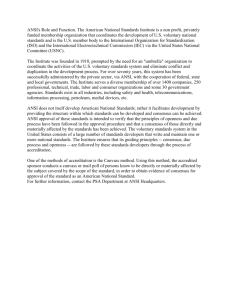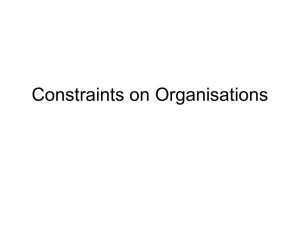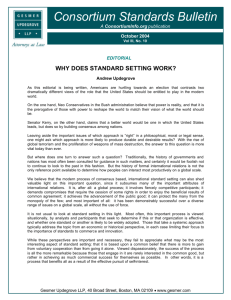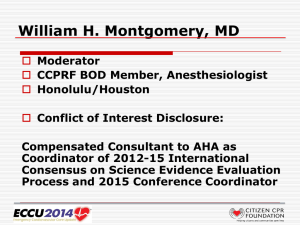The Standards Universe - Northwestern University
advertisement
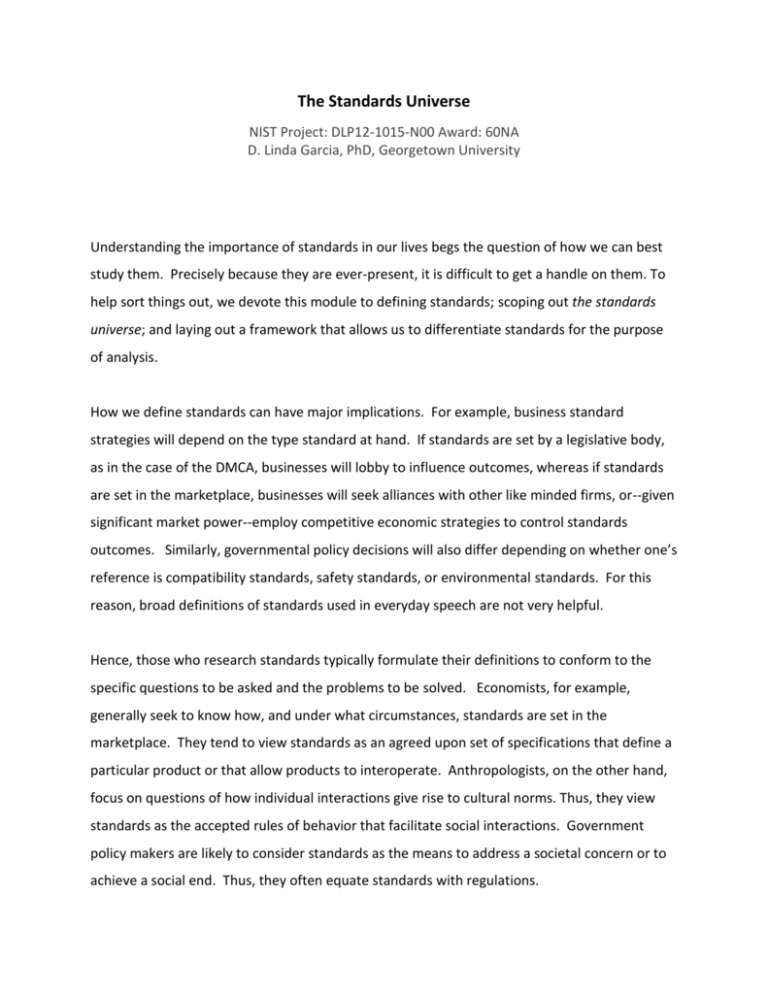
The Standards Universe NIST Project: DLP12-1015-N00 Award: 60NA D. Linda Garcia, PhD, Georgetown University Understanding the importance of standards in our lives begs the question of how we can best study them. Precisely because they are ever-present, it is difficult to get a handle on them. To help sort things out, we devote this module to defining standards; scoping out the standards universe; and laying out a framework that allows us to differentiate standards for the purpose of analysis. How we define standards can have major implications. For example, business standard strategies will depend on the type standard at hand. If standards are set by a legislative body, as in the case of the DMCA, businesses will lobby to influence outcomes, whereas if standards are set in the marketplace, businesses will seek alliances with other like minded firms, or--given significant market power--employ competitive economic strategies to control standards outcomes. Similarly, governmental policy decisions will also differ depending on whether one’s reference is compatibility standards, safety standards, or environmental standards. For this reason, broad definitions of standards used in everyday speech are not very helpful. Hence, those who research standards typically formulate their definitions to conform to the specific questions to be asked and the problems to be solved. Economists, for example, generally seek to know how, and under what circumstances, standards are set in the marketplace. They tend to view standards as an agreed upon set of specifications that define a particular product or that allow products to interoperate. Anthropologists, on the other hand, focus on questions of how individual interactions give rise to cultural norms. Thus, they view standards as the accepted rules of behavior that facilitate social interactions. Government policy makers are likely to consider standards as the means to address a societal concern or to achieve a social end. Thus, they often equate standards with regulations. However, our curriculum--Standards for Everyone-- requires an inclusive definition of standards that cuts across a wide array of activities. We need a definition that applies equally to the standard roles that bind organizations together as well as to the standard products, currencies and prices that unify markets. Viewed in the abstract, standards can be said to negotiate the boundaries between diverse phenomena. They provide the rules, or protocols, to be followed in order for objects to interact. Hence we define standards as the interfaces governing interactions, be they individuals, machines, words, or elements of the natural world. Accordingly, standard interfaces might govern the mode of interactions; define the conditions under which interactions take place; and/or signify the appropriateness of interactions. For example, to connect to the Internet, one must employ the TCP/IP protocol. Alternatively, to drive on the highways, cars must meet national environmental emission standards. Likewise, to select produce, consumers might look to foods that conform to ‘organic’ standards. Notwithstanding their universal nature, standards can be differentiated according to their purposes, as well as by how they are established. We identify three different kinds of standards: control standards, product standards, and platform standards. Likewise, we point to three standard setting mechanisms: a de facto process, a regulatory process, and a voluntary consensus process. These three kinds of standards and three different standards processed can be matched to form a matrix, which we have labeled The Standards Universe. . The Standards Universe Control standards are designed to constrain interactions either by forbidding an action; by establishing performance criteria that an interaction must meet; or by prescribing the method or design of an interaction. For example, early environmental quality standards on automobiles were design standards: they required that cars be equipped with a catalytic converter. Later standards, based on performance criteria left the design to the automaker, requiring only that certain emission levels not be breached. Product standards establish the conditions under, and criteria according to, which interactions take place. These standards typically relate to product attributes in terms of their quality, safety, and appropriateness for an intended purpose. A simple example of a product standard is the screw thread standard. The thread is a ridge wrapped around a cylinder or cone, which serves to convert between rotational and linear force. Supporting one of the most prolific machine products produced each year the screw thread standard was first developed as long ago as 1880. Platform standards define the architecture that links objects one to another in a networked configuration. For example, TCP/IP is the primary standard that governs access to the Internet. Designed as an open standard, TCP/IP has spawned multiple on-line users and uses. Because platform standards are the foundation for higher-level activities, which ride atop the platform, they facilitate innovation. Thus, for example, the World Wide Web was built atop of the Internet platform, while YouTube rode over the WEB. Each of these three types of standards can come about in one of three different ways. Some standards are unplanned; they emerge, from the bottom up, in the context of repeated interactions. For instance, imagine you are walking down the street, and you encounter a passerby coming in the opposite direction. If you are like most people, you will shift your step to the right, as will the passerby. Based on this learned standard of behavior, ingrained over time, each of you will limit your choice of action to avoid a collision. Such de facto standards also emerge in the market place, through iterations of consumer choices or because interested parties have successfully sponsored them. Nature, likewise, gives rise to de facto product standards through the evolutionary process of variation, selection, and replication. Thus, for example, flowers give off an electric current that has evolved over time, while the bee has coevolved to recognize the current as signaling the amount and quality of pollen to be harvested from that flower. Platform standards can also emerge from the bottom up, as the development of languages clearly attests. Many standards are prescribed from the top down by some legitimate authority. Thus, for example, the CEO of a firm can establish the formal roles that employees play, as well as the behavioral expectations associated with them. Such workplace standards are best illustrated in the classic 1955 movie, The Man in the Gray Flannel Suit, in which the protagonist, played by Gregory Peck, struggles to maintain his independence in the face of the pressures of a dominant material culture. Governments, operating at all levels, also impose standards in a top down fashion so as to achieve public policy goals. Thus, they may set control standards to regulate emissions, product standards to assure safety, and platform standards to provide for interconnection. The demand for standards often coincides with the emergence of new, advanced technologies. Most recently, for example, the prospect of private drones has led Google to call for privacy standards to regulate them. In the United States, the government relies, when possible, on voluntary consensus organizations to develop standards, which are subsequently mandated by law. Midway between the market and the government is the voluntary consensus standards process, carried out in the private sector by standards development organizations (SDOs). This voluntary consensus process resembles top down processes insofar as voluntary standards derive their authority from the consensual process in which they are developed. However, voluntary consensus standards approximate market-based standards in that the influence that participants in the process can exert to promote a standard often reflects their market power. In the United States, the first SDOs emerged to address the problems and issues associated with industrialization. New SDOs were formed in response to specific needs as they arose. Hence they took a variety of forms, and operated independently of one another. Notwithstanding their independence, American standards organizations resemble one another in several ways. In particular, they all arrive at decisions through a process of consensus and provide some level of due process. In addition, they all have mechanisms for participation, comment, and appeal. In contrast to top down, prescribed standards, the adoption of SDO standards is voluntary. However, conformance to such standards is high, given the network externalities associated with a standard that has a wide spread appeal. This characterization of the Standards Universe provides a reference model for categorizing standards according to the problems they seek to address and the issues to which they give rise. As well, by depicting standards and standards processes according to a variety of dimensions, this reference model provides a basis for drawing new insights about standards based on a comparison of a broad range of contexts in which standards are developed.


